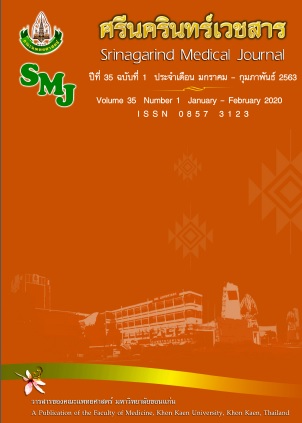Abnormality of Aortic Arch Branching in a Thai Embalmed Cadavers and its Clinical Application: A Rare Case Report
Keywords:
Abnormality of aortic arch branchingAbstract
Background and Objective: In normal development, the aortic arch (AA) gives 3 major branches: 1) Brachiocephalic trunk, 2) Left common carotid artery, and 3) Left subclavian artery. The abnormality of those AA branching is important for thoracic surgery consideration. Although the abnormality of aortic arch branching has been reported in some races, this abnormality in Thai cadavers has never been investigated previously.
Method: Dissections in this study were performed in Thai embalmed cadavers during teaching gross anatomy for Medical students of Ubon Ratchathani university. The cadavers were carefully dissected thoracic region to investigate the anatomical structures of AA branching. This study was carried out from 10 female and 12 male cadavers.
Result: From total 22 cadaveric samples, it was noted that only one male cadaver (58 years old, 4.55% of total investigated samples) has abnormality of the left vertebral artery obviously projected from the AA by running out between the left common carotid artery and left subclavian artery.
Conclusion: The information of this rare variation in the origin of vertebral artery from the AA is of the most importance to surgeons performing surgery in thoracic region. For radiologist, it is noted to avoid the misinterpretation of radiographs during performing angiography.
References
2. Drake RL, Vogl AW, Mitchell AWM. Gray's Anatomy for Students. 2nd ed. Philadelphia, Churchill Livingstone, 2010.
3. Moor KL, Dalley AF, Agur AMR. Clinically oriented anatomy. 7th ed. Philadelphia, Lippincott Williams & Wilkins, 2014.
4. Turkvatan A, Buyukbayraktar FG, Olçe T, Cumhur T. Congenital Anomalies of the Aortic Arch: Evaluation with the Use of Multidetector Computed Tomography. Korean J Radiol 2009; 10: 176-84.
5. Shiva-Kumar GL, Pamidi N, Somayaji SN, Nayak S, Vollala VR. Anomalous branching pattern of the aortic arch and its clinical applications. Singapore Med J 2010; 51: e182-3.
6. Patil ST, Meshram MM, Kamdi NY, Kasote AP, Parchand MP. Study on branching pattern of aortic arch in Indian. Anat Cell Biol 2012; 45: 203-6.
7. Wanamaker KM, Amadi CC, Mueller JS, Moraca RJ. Incidence of aortic arch anomalies inpatients with thoracic aortic dissections. J Card Surg 2013; 28: 151-4.
8. Arnaiz-Garcıa ME, Gonzalez-Santos JM, Lopez-Rodriguez J, Dalmau-Sorli MJ, Bueno-Codoner M, Arevalo-Abascal A, et al. A bovine aortic arch in humans. Indian Heart J 2014; 66: 390–1.
9. Hanneman K, Newman B, Chan F. Congenital Variants and Anomalies of the Aortic Arch. Radiographics 2017; 37: 32–51.
10. Bhattarai C, Poudel PP. Study on the variation of branching pattern of arch of aorta in Nepalese. Nepal Med Coll J 2010; 12: 84-86.
11. Hsu KC, Tsung-Che Hsieh C, Chen M, Tsai HD. Right aortic arch with aberrant left subclavian artery-prenatal diagnosis and evaluation of postnatal outcomes: Report of three cases. Taiwan J Obstet Gynecol 2011; 50: 353-8.
12. Jalali KB, Asadi MH, Rahimian E, Tahsini MR. Anatomical variations in aortic arch branching pattern. Arch Iran Med 2016; 19: 72-4.
13. Mustafa AG, Allouh MZ, Ghaida JH, Al-Omari MH, Mahmoud WA. Branching patterns of the aortic arch: a computed tomography angiography-based study. Surg Radiol Anat 2017; 39: 235–42.
14. Jayanthi V, Prakash Devi MN, Geethanjali BS, Rajini T. Anomalous origin of the left vertebral artery from the arch of the aorta: review of the literature and a case report. Folia Morphol (Warsz) 2010; 69: 258-60.
15. Müller M, Schmitz BL, Pauls S, Schick M, Röhrer S, Kapapa T, et al. Variations of the aortic arch - a study on the most common branching patterns. Acta Radiol 2011; 52: 738-42.
16. Dumfarth J, Chou AS, Ziganshin BA, Bhandari R, Peterss S, Tranquilli M, et al. Atypical aortic arch branching variants: A novel marker for thoracic aortic disease. J Thorac Cardiovasc Surg 2015; 149: 1586-92.
17. Wang L, Zhang J, Xin S. Morphologic features of the aortic arch and its branches in the adult Chinese population. J Vasc Surg 2016; 64: 1602-8.
18. Saeed UA, Gorgos AB, Semionov A, Sayegh K. Anomalous right vertebral artery arising from the arch of aorta: report of three cases. Radiol Case Rep 2017; 12: 13–8.
19. Ishikawa K, Yamanouchi T, Mamiya T, Shimato S, Nishizawa T, Kato K. Independent Anomalous Origin of the Right Vertebral Artery from the Right Common Carotid Artery. J Vasc Iterv Neurol 2018; 10: 25-7.
20. Beyaz P, Khan N, Baltsavias G. Multiple anomalies in the origin and course of vertebral arteries and aberrant right subclavian artery in a child with moyamoya syndrome. BMJ Case Rep 2018; pii: bcr-2017-013464 .




